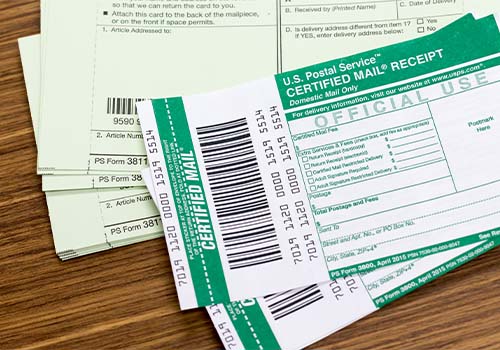Registered Mail VS Certified Mail | Definition & Difference
Table of Contents

Most people know how to mail a letter, but many people might not be familiar with the different types of mail service provided by the United States Postal Service. In most cases, simply dropping a letter in the mail is enough for most people. However, there might be times when you need something more than that. What if that letter is extremely important and you want to be absolutely certain that it is delivered to the intended recipient? This is where certified mail and registered mail can come in handy. These services provide additional levels of security and delivery assurance. Keep reading to learn what each of these services provides as well as the key differences between the two.
Certified Mail Overview
What is certified mail? Certified mail service was first introduced by the USPS in 1955. It was originally intended as a way to provide proof of delivery and receipt. The purpose of certified mail still remains much the same today. It allows a sender to receive proof of receipt of First Class mail, First Class packages, and Priority Mail. If you wish to send certified mail, then most people choose to visit their local post office to accomplish this task.
Many people wonder how to send certified mail. First, you will need to complete a certified mail form along with a certified mail return receipt. This return receipt is what will ultimately provide you with proof of delivery. When your mail or package is delivered to the recipient, they will need to sign for the mail. The recipient’s signature is captured on this return receipt, and that receipt is then returned to you – the sender. Years ago, these receipts were all paper and were returned to the sender through the mail. However, today electronic receipts are the most popular. This allows the sender to receive the receipt almost immediately upon delivery and view an electronic version of the signature. Some people request a duplicate return receipt service where they receive both an electronic version and a paper copy.
Certified mail travels through the post office infrastructure along with the First Class mail. It takes anywhere from 2 to 8 business days for delivery – essentially the same as regular First Class mail. Certified mail is not separated from the regular mail, and no insurance is provided by default. Tracking information is provided and a tracking number is available on your mailing receipt so that you can track certified mail as it moves along to its destination.
Registered Mail Overview
So, what is registered mail? Registered mail came along after certified mail to provide an even higher level of tracking and security. Registered mail is typically used for packages or mail that absolutely must make it to the addressee, and registered mail often contains valuables or valuable information. Registered mail also provides delivery confirmation and a return receipt. Registered mail is available for regular First Class mail, First Class packages, and Priority Mail. However, mail pieces sent using registered mail are provided an extra level of security and protection.
USPS registered mail pieces are generally kept separate from the regular mail. This provides greater detail in tracking and can be used to verify chain of custody for these pieces of mail. They are not left in sorting facilities or other areas unattended. At night, they are placed into locked safes, lockers, or sealed containers for additional security. Registered mail is the mail delivery service that would be used for your most important documents. Similarly, insurance coverage of up to $50,000 is available for items sent using registered mail.
The tracking numbers for registered mail are alphanumeric, and the tracking details provide more information about the status of the package than the standard USPS tracking numbers. Electronic verification will be provided to the sender upon delivery, and registered mail can take up to 30 days for delivery time in some cases. Collect on delivery service is also available for registered mail for an additional fee, meaning that the postal service will collect payment upon delivery of the item.
Registered VS Certified Mail: Key Differences

These two services are quite similar in many ways, although there are a few key differences between the two. So, what are the main differences between registered and certified mail? Here they are.
— Mail Handling
There is a big difference in the way that these two types of mail are handled. Certified mail is handled essentially the same way that regular mail is handled. The certified mail simply has a return receipt attached along with a certified mail form that allows the postal workers to easily identify it. Registered mail, however, is handled completely separately. Additional security measures are taken with registered mail items including locking it in sealed containers at night and keeping a highly detailed chain of custody log.
— Security
Not only do you occasionally need proof of mailing, but you need to make sure that your package is secure throughout its journey. Registered mail provides that additional layer of security. While certified mail travels along with the regular mail, registered mail is treated differently. It is never left unattended unless it is locked up. This security allows people to use registered mail to send highly sensitive documents like tax returns or other paperwork with personal information.
— Insurance
USPS certified mail does not include any insurance, although you can opt to purchase insurance on those packages. However, you can only purchase up to $5,000 worth of insurance on these items. People do not typically use certified mail for extremely valuable items. Registered mail, on the other hand, allows you to purchase up to $50,000 worth of insurance. Since registered mail is handled more securely, it is a safer option and more insurance is available for it.
— Delivery Timeframes
Registered mail can be significantly slower than certified mail. The delivery timeframe for certified mail is the same as regular First Class mail. It typically gets delivered within 2 to 8 business days. Registered mail, however, typically takes around 15 days to be delivered. In extreme cases requiring extra insurance and collect on delivery service, you might see that your registered mail takes up to 30 days for delivery.
USPS Transit Times For Registered & Certified Mail
So, what are the transit times for these types of service? It depends on the service that you are using as the underlying delivery service. Remember that certified mail and registered mail are extra options that you can purchase on top of your normal delivery. You can select these options for regular First Class mail, First Class package service, or Priority Mail service.
If you are sending certified mail using regular First Class service, then you can expect that your mail will arrive in approximately 2 to 8 business days. If you opted for Priority Mail service with the certified mail option, then it should be delivered in 1 to 3 business days. Since tracking information is provided along with a return receipt, you will be able to see the date of delivery on USPS.com or on your return receipt.
Registered mail service transit times are usually much longer than certified mail. Registered mail sent using first class service will usually take the U.S. Postal Service around 10 – 14 days for delivery. Registered mail using Priority Mail service is a little quicker, but it could still take 4 – 8 business days for delivery.
Cost Of Registered & Certified Mail
So, how much does certified mail or registered mail cost? Remember that the pricing of these services is independent of the postage that you will need to pay for your mail or package. You will pay certified mail or registered mail fees on top of your regular postage. Certified mail costs much less than registered mail. The cost of certified mail is $3.75 plus a return receipt fee of $1.85 for electronic and $3.05 for paper.
Registered mail prices start at $13.75. It is quite a bit more expensive than certified mail because of the insurance provided and the additional measures required to maintain the security of the package. Remember that registered mail offers detailed delivery information along with a copy of the recipient’s signature upon delivery and very strict security measures along the way.
The Bottom Line
If you have a mailer that needs proof of delivery, then certified mail or registered mail is the way to go. Registered mail will provide you an even higher level of security, although the price is higher and the delivery times are longer. You can rest easy knowing that your mail sent with either one of these services will make its way to the intended recipient, and you will be notified and given proof of that delivery.
Frequently Asked Questions
Does Registered mail require a signature?
Yes, registered mail requires a signature. Upon delivery of the item, the recipient will sign for it. The sender will be provided a copy of this signature either electronically or on the paper return receipt. The method depends upon which service the sender selected when mailing the item.
What is Registered mail used for?
Registered mail is usually used for sending valuable items or extremely important and confidential paperwork. This is because registered mail is highly secure, and it also includes $50,000 worth of insurance in the event of damage or loss.
What are the advantages of Certified mail?
One advantage is that certified mail travels fairly quickly since it moves along with the regular mail. In addition, certified mail service is not extremely expensive. The certified mail fee plus the return receipt fee is less than $6 together if you choose the electronic option. Plus, this service provides you with proof of delivery and you can even purchase proof of mailing as well.
What are the benefits of Registered mail?
The main benefit of registered mail is the security provided with this service. You can rest assured that the contents of your letter or package will be safe and secure as it travels to its destination. These mail pieces are locked in safes or sealed containers overnight, and they are never left unattended. This helps keep the chain of custody in place, and extremely detailed tracking information is available for these items.
